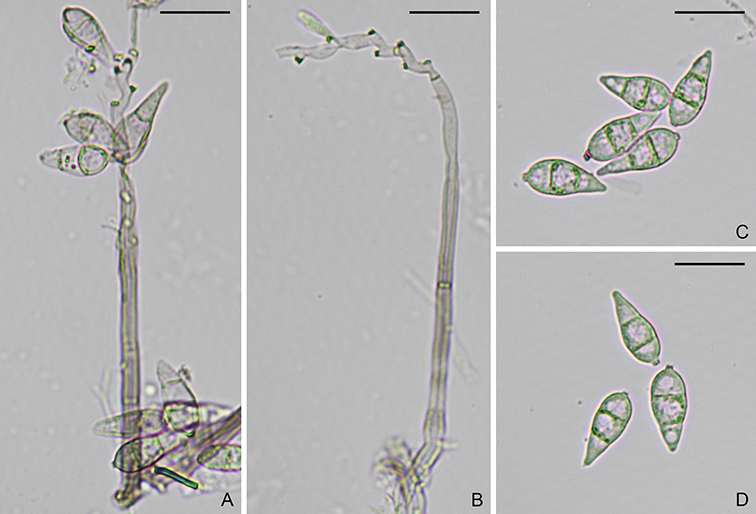
Pyricularia ctenantheicola Klaubauf, M.-H. Lebrun & Crous, Stud. Mycol. 79: 111 (2014).
MycoBank: MB810219.
On CMA with sterile rice seeds, hyphae branched, septate, hyaline, smooth, 1.5–2 μm diam. Conidiophores solitary, erect, straight or curved, branched to unbranched, 1–6-septate, medium brown, smooth, 100–190 × 3–5.5 μm. Conidiogenous cells integrated, terminal or intercalary, light brown, smooth, 35–96 × 3–5 μm, with several protruding denticles, 1–2 × 1–2 µm. Conidia solitary, pyriform to obclavate, 2-septate, light brown, smooth to finely roughened, 20–25 × 7–9 μm, with a truncate hilum, 0.5–1.5 × 1–2 µm. Sexual state unknown.
Colonies on 3.5 cm diam PDA after 7 days at 25 °C in dark; surface hazel, with smoke grey tufts; reverse hazel. Colonies on MEA 2.7 cm diam after 7 days at 25 °C in dark; surface white to vinaceous buff, cottony, with undulating margin; reverse ochraceous to umber. Colonies on CMA 2.5 cm diam after 7 days at 25 °C in dark; surface pale luteous, with hazel center. Colonies on OA 3.5 cm diam after 7 days at 25 °C in dark (Description from Klaubauf et al., 2014).
Typification: Holotype CBSH21842. Ex-holotype culture CBS138601 (GR0002).
Gene sequences: KM484878 (ITS), KM484994 (28S), KM485182 (ACT), KM485252 (CAL), KM485098 (RPB1).
Specimens examined: Greece, Almyros, on Ctenanthe oppenheimiana, 1998, A.C. Pappas and E.J. Paplomatas, culture CBS138601.
Hosts/substrates: On Ctenanthe oppenheimiana (Marantaceae).
Distribution: Greece.
Copyright 2022 by The American Phytopathological Society. Reproduced, by permission, from Luo, J., and Zhang, N. 2022. The Rice Blast Fungus and Allied Species: A Monograph of the Fungal Order Magnaporthales (https://my.apsnet.org/APSStore/Product-Detail.aspx?WebsiteKey=2661527A-8D44-496C-A730-8CFEB6239BE7&iProductCode=46826). American Phytopathological Society, St. Paul, MN.